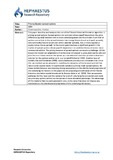| dc.contributor.author | Giannopoulos, Kostas | |
| dc.date.accessioned | 2015-12-10T16:46:55Z | |
| dc.date.available | 2015-12-10T16:46:55Z | |
| dc.date.issued | 2006 | |
| dc.identifier.uri | http://hdl.handle.net/11728/6554 | |
| dc.description.abstract | This paper describes and analyses the use of the Filtered Historical Simulation algorithm in pricing spread options. Spread options are contracts whose payoff depends on the price difference (spread) between two or more underlying assets at a future date. Such kind of options are written in the spread between two energy futures (crack and spark spreads), two commodity futures (crush and cotton calendar spreads), two or more equities or equity indices (index spread). In the recent years has been a significant growth in the market of spread options whose payoffs depend on the creditworthiness of one or more commercial entities. The pricing however of spread options represents a challenge. All the known the models are adaptations of earlier ones introduced to price plain vanilla calls and puts. Some of those consider the spread as a variable itself and then provide a close form solution for the options written on it, e.g. Longstaff-Scharttz (1993). Another type of models, Das and Sundaram (1998), uses a backward procedure on a bivariate tree. Since this last method can be adopted in modelling the dynamics of the forward and risk free rate in a risk neutral mode, it is particularly suitable in pricing credit spread options. All these models however are imposing strong assumptions on the distributional proprieties of the underlying risk factors. In this paper we are proposing a modification of the filtered historical simulation model introduced by Barone-Adesi et.al. (1998). First we generate pathways for the mean and the variance for a set of underlying factors and at each node we price any options written on the spread of these simulated patrhways. The advantage of this model is that is a semi-parametric one, in the sense that does not impose any restrictions on the distributional proprieties of the underlying risk factors. | en_UK |
| dc.language.iso | en | en_UK |
| dc.publisher | Society for Computational Economics | en_UK |
| dc.relation.ispartofseries | Computing in Economics and Finance 2006;No 252 | |
| dc.rights.uri | http://creativecommons.org/licenses/by-nc-nd/4.0/ | en_UK |
| dc.subject | Option | en_UK |
| dc.subject | Pricing | en_UK |
| dc.title | Pricing Basket spread options | en_UK |
| dc.type | Article | en_UK |


